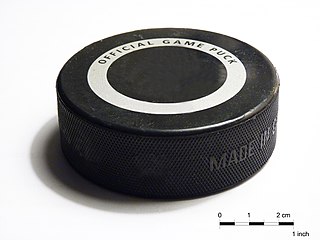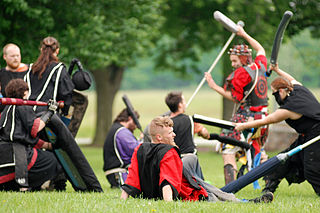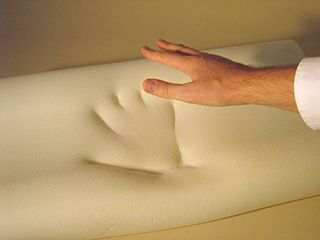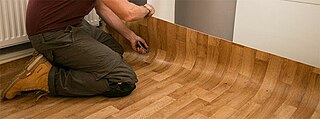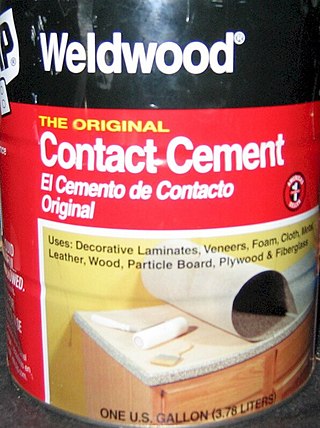Construction of a sprung floor
Sprung floors come in a few major types: [13]
- Traditional wood basket-weave
- Wood with high durometer neoprene pads. Sometimes both basket-weave and neoprene pads are used.
- Foam rubber with a wood or other area elastic layer on top
- A few sprung floors use actual springs - the special spring floors used by cheerleaders and tumblers often have coil springs under them.
The construction may be built into the area, or it may be composed of modules that slot together and can be disassembled for tours.
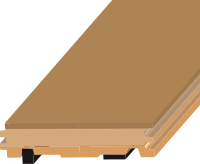
Performance halls should be designed and built with sprung floors in mind. A depth of at least 10 centimetres (3.9 in) should be allowed for the floor. This can be a major constraint when laying a sprung floor in a hall not designed for it. Most can accommodate a maximum of 5 cm (2.0 in), and some sprung floors designed for refurbishments are as low as 3 cm (1.2 in). [14] Ramps for wheelchairs will be needed at the doors. If the ramp is outside the hall, the doors will need the bottoms trimmed off (easing) and their height will therefore be reduced. Ramps can have a 1:12 incline at most, and they may also need a safety zone around them. Thus if the floor is 5 cm deep, the ramp should be 60 cm (24 in) long or more. The underfloor needs to be made flat either with levelling cement, very careful trowelling, or by using shims and a layer of masonite. Any new cement must be allowed to dry for at least a month. A membrane vapour barrier should be used to prevent moisture from the ground.

A semi-traditional floor would have wood battens laid on pads made of neoprene, which is more durable than rubber. Pads are typically laid 40–50 cm (16–20 in) apart and are 1–2.5 cm (0.39–0.98 in) thick. Then more wood battens are put on top at right angles, halfway between the pads. A traditional floor might have three layers of this springing. Then two layers of plywood are placed on top, offset by 45–90 degrees so that the joints do not match up. The plywood spreads the load. Finally, the actual surface is made from a layer of strong, durable wood like oak, beech or maple, or other types of wood that are covered with a vinyl surface. There may also be provision to prevent the floor from depressing too much if a very heavy weight is placed on it.
There should normally be a fairly wide gap between the floor and the wall to allow for expansion and to allow air to circulate. This is often covered by a skirting board or molding, to make the gap less apparent. It is because the floor is free-standing, rather than connected to walls or joists, that it is also referred to as a floating floor.
The performance surface is normally of vinyl or hardwood, engineered wood or laminate. For dance the surface may be replaceable, so that a theatre can adapt easily to either ballet or tap dance.
Generating power from dance
A number of green nightclubs, including Rotterdam's Club Watt, have installed sprung floors which help generate power for their music and lightshows. The floors are suspended on transducers that act like shock absorbers. To absorb the energy produced by dancers, piezoelectric crystals are used. When compressed, these crystals charge nearby batteries. [15] [16] [17]
Open and closed cells
The neoprene pads used in sprung floors may be described as having open cells or closed cells. A cell is a void inside the neoprene, which may be a single cell or a network of small ones.
A closed cell is like a balloon, where the air inside cannot escape and the pad is bouncy and returns most of the energy put in. A pad with many small, closed cells may also be referred to as a foam, but typically only a single large closed cell is used, as the cell can expand sideways and so provides characteristics more like a long spring.
Open cells have small holes which let the air inside escape and tend to dissipate the energy input. A pad with many open cells may also be referred to as a sponge.
As with everything to do with sprung floors, a combination of types is often used. A core of softer durometer may have a harder outer layer shaped so that heavy falls encounter more resistance instead of 'bottoming out' to a concrete subfloor. This also protects against deformation by heavy weights like pianos.
Portable dance floors
Portable dance floors are mobile dance floors which provide a temporary surface for dancing. They can be installed quickly in any area by laying down panels and placed in a cart for ease of storage. They can be designed for both indoor and outdoor use.
A portable dance floor is typically about 1⁄2 to 1 inch thick (1.3 to 2.5 cm), and consists of many 3 ft × 3 ft (0.91 m × 0.91 m) panels to create the desired size. There is trim edging around the border, allowing users to enter the floor safely. The portable panels are constructed from either oak parquet, for indoor use, or honeycomb aluminum and laminate for indoor and outdoor use. Other portable dance floors are made out of a polypropylene base with a commercial grade laminate top surface. These floors are extremely durable and often used in the event-planning, hospitality industries. While older-style portable dance floors feature solid-wood construction, many portable dance floors use an interlocking system for a simple system to connect the pieces. High-quality, weather-resistant, portable dance floors are also engineered to be used for both indoor and outdoor applications.
Portable dance floors are commonly used for events like parties and weddings or conferences where there is no permanent dance floor available. They may also be used on cruise ships or in schools as a way to utilize limited space.
